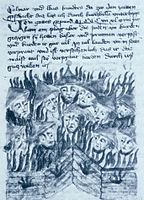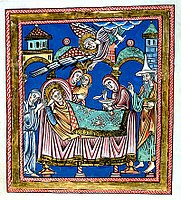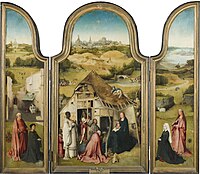Jewish hat

The Jewish hat, also known as the Jewish cap, Judenhut (
Modern distinctive or characteristic Jewish forms of male headgear include the kippah (skullcap), shtreimel, spodik, kolpik, and kashkets; see also Hasidic clothing.
Europe
Shape
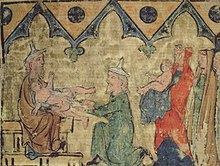
The shape of the hat is variable. Sometimes, especially in the thirteenth century, it is a soft Phrygian cap, but rather more common in the early period is a hat with a round circular brim—apparently stiff—curving round to a tapering top that ends in a point,[1] called the "so-called oil-can type" by Sara Lipton.[2] Smaller versions perching on top of the head are also seen. Sometimes a ring of some sort encircles the hat an inch or two over the top of the head. In the fourteenth century a ball or bobble appears at the top of the hat, and the tapering end becomes more of a stalk with a relatively constant width.[3] The top of the hat becomes flatter, or rounded (as in the Codex Manesse picture). The materials used are unclear from art, and may have included metal and woven plant materials as well as stiffened textiles and leather.
By the end of the Middle Ages the hat is steadily replaced by a variety of headgear including exotic flared Eastern style hats, turbans and, from the fifteenth century, wide flat hats and large berets. In pictures of Biblical scenes these sometimes represent attempts to portray the contemporary dress of the time worn in the Holy Land, but all the same styles are to be seen in some images of contemporary European scenes. Where a distinctive pointed Jewish hat remains it has become much less defined in shape, and baggy. Loose turbans, wide flat hats, and berets, as well as new fur hat styles from the Pale of Settlement, remain associated with Jews up to the eighteenth century and beyond.
History
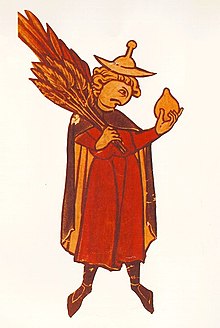
The origin of the hat is unclear, although it is often seen as ultimately evolving from the same origin as the mitre, perhaps from late Roman styles, which may themselves derive from the hats of ancient Persian clergy. Hats worn (by Pharaoh's advisors, among others) in the illustrations to the Old English Hexateuch, a manuscript of around 1030, have been seen as an early form, and they appear in the Mosan Stavelot Bible of 1097.[4]
The first recorded instance of a “Jewish hat” or “Judenhut” was around the 11th century in the Flanders region.[5] The wearing of these distinctive hats originate from European Christians who wore such hats before mandating that it become a symbol for European Jews. According to Sara Lipton, "The few surviving early medieval references to Jewish clothing likewise suggest that Jews dressed no differently from their Gentile neighbor".[6]
In Europe, the Jewish hat was worn in France from the eleventh century, and Italy from the twelfth. The Gniezno Doors were probably made in Germany around 1175, and two Jewish merchants depicted on the doors wear them. Under Jewish law, observant Jews should keep their heads covered almost all the time,[7] and indeed men of all religious groups tended to wear hats when outside in the Middle Ages to a much greater extent than today.[8]
Unlike the

The Fourth Council of the Lateran of 1215 ruled that Jews and Muslims must be distinguishable by their dress (Latin "habitus"), the rationale given being: "In some provinces the dress of Jews and Saracens distinguishes them from Christians, but in others a degree of confusion has arisen, so that they cannot be recognised by any distinguishing marks. As a result, in error Christians have sexual intercourse with Jewish or Saracen women, and Jews and Saracens have intercourse with Christian women. In order that the crime of such an accursed mingling shall not in future have an excuse and an evasion under the pretext of error, we resolve that (Jews and Saracens) of both sexes in all Christian lands shall distinguish themselves publicly from other people by their dress. According to the testimony of scripture, such a precept was already made by Moses (Lev.19.19; Deut.22.5.11)".[12]
Local regulations
However, not all European medieval monarchs followed these pontifical resolutions. King
, despite some of the earliest examples being seen in Italy, and was not found in Spain.Additional rules were imposed by local rulers at various times. The council decision was confirmed by the Council of Vienne of 1311–12. In 1267 the hat was made compulsory in Vienna. A doctor was given a temporary dispensation from wearing it in Venice in 1528, at the request of various distinguished patients[14] (at the time in Venice each profession had special clothing rules). Pope Paul IV ordered in 1555 that in the Papal States it must be a yellow, peaked hat, and from 1567 for twenty years it was compulsory in Lithuania, but by this period it is rarely seen in most of Europe.[15]
As an outcome of the
Such examples of this hat-wearing can be seen nearly 350 years after the Fourth Lateran Council. Regions divided into many states, such as Renaissance Italy and Germany, had local laws in this as in other fields, leading to difficulties for travellers who might not be aware of the local regulations. For example, in Italy a Leone Segele was arrested in Lodi for wearing a black hat, as was acceptable in his home city of Genoa, instead of a yellow one, required in Lodi.[18] These dress codes became a normal part of what it meant to be a Jew living inside Catholic dominated European societies.[19]
In a late addition to local rulings, the very strict and locally unpopular
In art
The Jewish hat is frequently used in medieval art to denote Jews of the Biblical period. Often the Jews so shown are those shown in an unfavourable light by the story being depicted, such as the money-changers expelled by Jesus from the Temple (Matthew 21:12–17), but this is by no means always the case. The husband of Mary,
However, in Christian art the wearing of the hat can be sometimes be seen to express an attitude to those wearing it. In one extreme example in a manuscript of the
William III the Brave (1425–1482) of Meissen, minted a silver groschen known as the Judenkopf Groschen. Its obverse portrait shows a man with a pointed beard wearing a Judenhut, which the populace took as depicting a typical Jew.[27]
Transfer
When the plague broke out in 1349, Jews were expelled from much of German-speaking Europe. The pointed hat which had formerly been used to depict Jews, now was also used for other outcasts. Naomi Lubrich claims that the pointed hat was transferred in iconography to criminals, pagans, and other non-Christian outsiders, in particular sorcerers[28] and dwarfs.[29] Among the examples are laws, for example in Hungary in 1421, according to which people convicted of sorcery were forced to put on a Jewish hat for public shaming.
Regulated dress for Jews in the Islamic world
For dhimmis to be clearly distinguishable from Muslims in public, Muslim rulers often prohibited dhimmis from wearing certain types of clothing, while forcing them to put on highly distinctive garments, usually of a bright colour. These included headgear, though this was not usually the primary element. At some times the regulated dress of Christians and Jews differed, at others it did not. As in Europe, the degree to which the recorded regulations were enforced is hard to assess, and probably varied greatly.
Islamic scholars cited the
Regulations on dhimmi clothing varied frequently to please the whims of the ruler. Although the initiation of such regulations is usually attributed to Umar I, historical evidence suggests that it was the Abbasid caliphs who pioneered this practice. In 850 the
Gallery
-
Saint Helena Finding the True Cross, Weissenau Abbey, Germany, c. 1170
-
Bronze Serpent, German, c. 1225–1230
-
German Jews of the twelfth century. From Herrad von Landsperg, Hortus deliciarum
-
Burning and killing of Jews by the Knight Volkmar at the time of the First Crusade (Prague)
-
Valdemar Atterdag holding Visby to ransom, 1361, by Carl Gustaf Hellqvist (1851–1890) features a Jewish merchant wearing a Judenhut (at right).
-
Adoration of the Magi by Hieronymus Bosch, with the infant Christ being shadowed by the Jewish "false Messiah", who is seen half-naked wearing a pointed cap in the stable doorway.
-
Judenkopf Groschen
See also
- Conical hat
- Court Jew
- Dhimmi laws
- Ethnic segregation
- Fulani hat
- Ghetto, Melah
- List of hats and headgear
- Ottoman Millet system
- Tembel hat
- Yellow badge
- Clothing laws by country
Notes
- ^ For example as worn by the Old Testament figures on the Klosterneuburg Altar of 1181
- ^ Lipton, 16
- ^ Occasionally small straight "stalks" are seen earlier, e.g. Schreckenberg:77, illus 4, of c. 1170
- ^ Silverman, 55-56
- ^ Silverman, Eric (2013). A Cultural History of Jewish Dress. Bloomsburg Academic. pp. 55–57.
- ^ Sara, Lipton (2014). Dark Mirror: The Medieval Origins of Anti-Jewish Iconography. Henry Holt and Company. p. 15.
- ^ Although this may not yet have acquired the force of law at this period. See Roth op cit.
- ^ Silverman, 56
- ^ Piponnier and Mane, p. 138; Silverman, 57; Seals from Norman Roth, op cit. Also Schreckenburg p. 15 & passim.
- ^ Piponnier & Mane, 138 (quoted)
- ^ Medieval Jewish History: An Encyclopedia. Edited by Norman Roth, Routledge Archived 2008-02-25 at the Wayback Machine
- ^ Schreckenburg, p.15
- ^ Fehér, J. (1967). Magyar Középkori Inkvizicio. Buenos Aires, Argentina: Editorial Transilvania.
- ^ "Mantino, Jacob ben Samuel". Jewish Encyclopedia. Retrieved 5 July 2014.
- ^ Papal Bull Cum nimis absurdum. Lithuania, JE: "Yellow badge".
- ^ Schreckenburg:288-296
- ^ For example in the enigmatic illustrations to the Golden Haggadah of Darmstadt, of about 1300. See sacrifice illustration below also.
- ^ Cassen, Flora (2019). "Jewish Travelers in early Modern Italy: Visible and Invisible Resistance to The Jewish Badge".
{{cite journal}}: Cite journal requires|journal=(help) - ^ Cassen, Flora.“Jewish Travelers in Early Modern Italy: Visible and Invisible Resistance to The Jewish Badge.” Academia, November 28, 2019.
- ISBN 978-0295980256.
- ISBN 978-0871691149.
- ^ Schreckenburg: 125–196. A twefth-century English example is in the Getty Museum Archived 2010-06-07 at the Wayback Machine
- ^ Lipton, 16-19, 17 quoted
- ISBN 0-7011-2514-4; Lipton, 16-17
- ^ Lipton, 18; the image is on folio 25c of Vienna ONB Codex 1179 Bible moralisée.
- ^ Lipton, 19; ONB Codex 1179, f. 181a
- ^ Saurma no. 4386
- ^ Naomi, Lubrich. ""From Judenhut to Zauberhut: A Jewish Sign Proliferates", in: Asdiwal, 10, 2015, 136–162".
- JSTOR 24709777.
- ISBN 0-8386-3943-7. p. 91
- ^ Medieval Jewish History: An Encyclopedia. Edited by Norman Roth, Routledge Archived 2008-10-24 at the Wayback Machine
- ^ a b Bat Ye’or (2002), pp. 91–96
References
- Parts of this article are translated from de:Judenhut of 13 July 2005
- Judenhut at the Jewish Encyclopaedia
- ISBN 0520215516, 9780520215511, Amazon preview
- Lubrich, Naomi, “The Wandering Hat: Iterations of the Medieval Jewish Hat”, in: Jewish History, 29 (2015), 203–244
- Lubrich, Naomi, “From Judenhut to Zauberhut: A Jewish Sign Proliferates”, in: Asdiwal, 10, 2015, 136–162
- Françoise Piponnier and Perrine Mane; Dress in the Middle Ages, Yale UP, 1997; ISBN 0-300-06906-5
- Roth, Norman, "Was There a "Jewish Hat"?"
- Schreckenburg, Heinz, The Jews in Christian Art, 1996, Continuum, New York, ISBN 0-8264-0936-9
- Silverman, Eric, A Cultural History of Jewish Dress, 2013, A&C Black, ISBN 1847882862, 9781847882868, google books
Further reading
- Straus Raphael, The "Jewish Hat" as an Aspect of Social History, Jewish Social Studies, Vol. 4, No. 1 (Jan., 1942), pp. 59–72, Indiana University Press. JSTOR 4615188.





